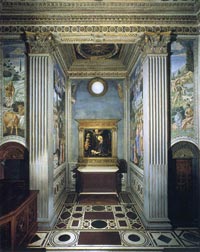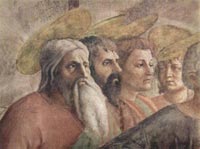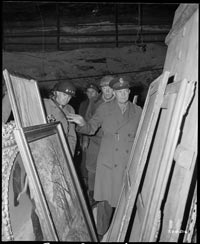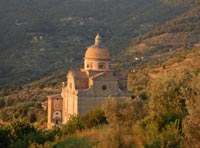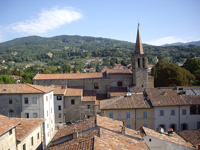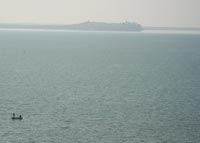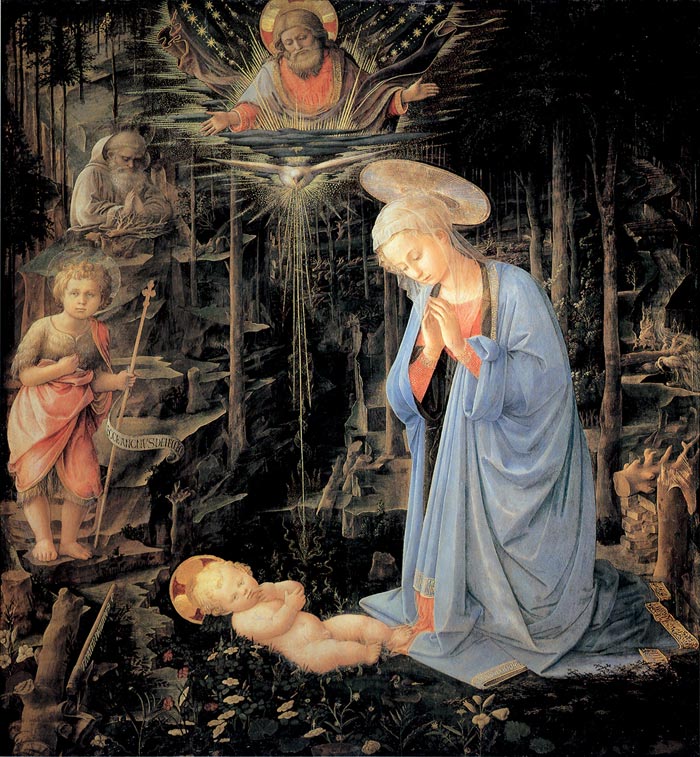 |
|
Fra Filippo Lippi, The Madonna in the Forest, c. 1460, oil on panel, 127 x 116 cm, Staatliche Museen, Berlin |
|
Filippo Lippi | Adoration in the Forest |
| The Adoration in the Forest is a 15th century [completed by 1459] painting by the Carmelite friar, Filippo Lippi, of the Virgin Mary and the newly born Christ Child lying on the ground, in the unusual setting of a steep, dark, wooded wilderness. There are no shepherds, kings, ox, ass – there is no Joseph. "Lippi removes a whole range of narrative details which would have been present in a standard Nativity - he creates a whole set of mysteries, and then preserves them."[1] It was painted for one of the wealthiest men in Renaissance Florence, the banker Cosimo de Medici. In later times it had a turbulent history. Hitler ordered it to be hidden in WW2 and it became part of the story of a mutiny in the U.S. Army - 'the only known case in the whole Second World War of American officers refusing an order.' It is now in the Gemäldegalerie, Berlin. |
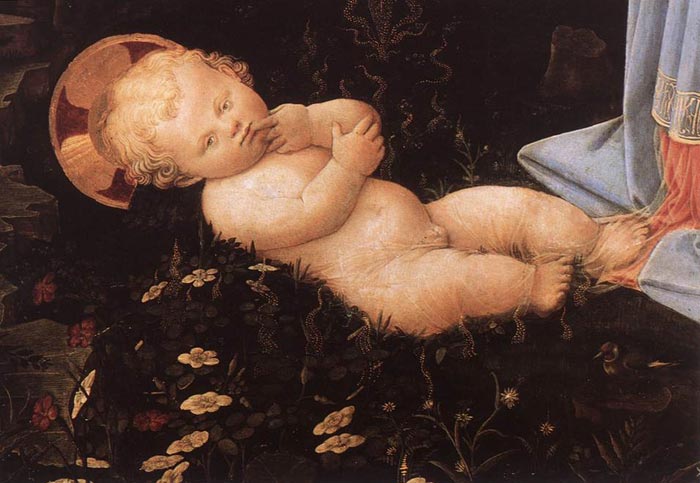 |
||
Fra Filippo Lippi, The Madonna in the Forest (detail), c. 1460, oil on panel, 127 x 116 cm, Staatliche Museen, Berlin |
||
Cosimo de Medici and Filippo Lippi |
||
Florence in the 1440s was at an expansive moment in its history. A lot of money was going into building, including the future home of Lippi's Adoration, Cosimo de Medici's home. Cosimo was the wealthiest man in Florence, a man of power, an adept Italian politician and his home spoke of an attitude of powerful confidence. Yet, in private, he was also a troubled man. He had led a sinful life, had fathered a bastard child on a slave girl, and grown rich by lending money and charging interest – usury – a practice to be punished by an eternity in Hell. Tim Parks: " He was a genuinely religious man, concerned about his soul, and that was a rather large problem for a banker."[2] He set about making amends for his sins in building and art. "Inside his new palace, the first domestic chapel built in all of Italy, as a peace offering to God; a place for Cosimo to kneel and do penance. The walls were decorated with extravagant frescoes, including a portrait of Cosimo himself. But the heart of the room would be the altarpiece - this would be a Nativity, but of a kind never seen before, one that would echo Cosimo's very deepest hopes and fears. " He chose an artist famous not just for his art, but one whose eye for beauty extended beyond pictures, to women , with scandalous results; - a Carmelite friar - Fra Filippo Lippi. Born in Florence around 1406, Lippi's father was a butcher, and the family home on the south bank of the Arno River. By the age of 8 Lippi was an orphan, and placed into the care of the local convent, Santa Maria del Carmine, which towered over the neighbourhood. So Lippi had not chosen to become a monk, but was to be trained to be one. It was a fortunate home for a youngster of an artistic bent; in the 1420s a chapel there was being decorated - 'and the result was one of the most groundbreaking and beautiful works of the Italian Renaissance. |
The Madonna in the Forest was made for the chapel of the Medici (later Medici-Riccardi) Palace. Originally on the altar of the chapel, it was replaced with a copy in 1494. |
|
The Brancacci Chapel in Santa Maria del Carmine, Florence
|
||
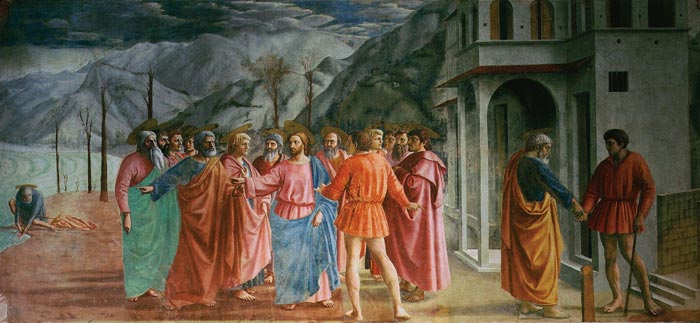 |
||
Masaccio, The Tribute Money, fresco in the Brancacci Chapel in Santa Maria del Carmine, Florence
|
||
The artist was Masaccio. In his art, "Biblical characters suddenly seemed real people..lit by the sun...moving in the real world, convulsed by real emotions.' Jeffrey Ruda: " Masaccio's work was profoundly important for Filippo Lippi - it gave him a profoundly new way to think about representation, about showing figures, using light and shadow to bring out a sense of shape and presence and to give the figures placement in a world that was grounded in gravity." "Lippi's earliest surviving work shows the influence of Masaccio's bold sculptural figures, transformed by a grace and delicacy that were Lippis own." By the age of 30 Filippo Lippi had left the convent and begun to earn a living as a professional artist though he remained a friar. As the years passed, his growing fame drew him inexorably into the circle of the city's leading artistic patron, the de facto ruler of Florence, the man who would commission The Adoration, Cosimo de Medici. At first Cosimo paid Lippi to produce pleasing religious scenes for his new home. Lippi had, all the while , the reputation of a man who liked to live life to the full - but in the late 1450s real scandal broke, and Lippi embroiled in a Nativity all of his own. For three years he had been working in the small town of Prato, near Florence, painting a huge fresco cycle in the Cathedral – also conducting a daily Mass – in the local nunnery. The story goes that he persuaded the abbess to let a young nun he liked - Lucrezia Buti - sit for him - and then she and Lippi absconded together. Just 20 at the time, Buti's seduction by the 50 year old friar threw Prato into an uproar. A son Filippino Lippi, later a famous painter himself, duly arrived. Cosimo however, smoothed over any scandal and Lippi returned to Florence to create Cosimo's groundbreaking Nativity. |
In Masaccio's art, 'Biblical characters suddenly seemed real people, moving in the real world, convulsed by real emotions. Lippi's earliest surviving work shows the influence of Masaccio's bold sculptural figures. It was said the spirit of Masaccio had entered Filippo Lippi. (Above , Masaccio's The Tribute Money) |
|
|
||
John the Baptist, Bernard of Clairvaux, the Trinity |
||
It is likely that the patron and the artist discussed the plan for the altarpiece carefully – it would need to reflect and deepen Cosimo's penitent mood. The painting was a defining example of a new genre in art – The Adoration – which focuses intensely on Mary and the Infant Christ, and for this Lippi drew upon the teachings of a medieval saint, Bridget of Sweden, who in visions had seen exactly how Christ had entered the world. "This wasn't God floating amid the cumuli, this was God made man, put amongst the rocks, the very stuff of which our world was made."[3]
|
||
Fate of the painting |
||||
| In 1494 the Medici family was expelled from Florence, their palace ransacked, and many statues and paintings carried off. The most important artworks were seized by the state and taken to the seat of government, the Palazzo della Signoria. Lippi's Adoration was installed over the altar of the Republican government's own chapel. Just two decades later however the Medici returned to Florence in triumph and moved back into their palace - citizens and state alike gave up their looted art and so the Adoration found its way back to its original home. It remained there for three centuries , until the first years of the 19th century , when a wealthy English trader living in Prussia, Edward Solly, entered its story. Solly was a merchant who had settled in Berlin, a trader in timber and grain - Prussia lived off trade with these goods and trade to Britain was an important part of the Prussian economy. He had become one of the wealthiest men in Berlin and had a palatial mansion yards from the Brandenburg Gate. He also had a passion for early Italian art and begun to build up an extraordinary collection of over 3000 paintings, the largest private collection of western art in the world. It was a good moment for collectors - Napoleon I was in control of Italy and had imposed punitive taxes on its wealthy families, forcing them to sell off much of their art - Solly acquired Lippi's Adoration, most probably for just a few pounds. But it was Napoleon who was also to prove the undoing of Solly when he established a naval blockade across the seas of Europe. "Solly was one of the people very personally affected by that because his own specialty was no longer possible - legally at least." At first Solly did well, making huge profits, as his merchant ships ran the blockade, but then disaster struck. The Danish, allies of Napoleon, seized no fewer than 20 of his ships, complete with cargo. Solly was in danger of going bust - his proposed solution - to sell his entire art collection to the Prussian state. The price , 500000 thalers, represented 1% of the entire state budget, but it was still a bargain. In 1821, at a stroke, when the deal was sealed, Prussia could boast one of the finest art collections in the world. Lippi's Adoration now went on display to the general public for the first time, at the Royal Museum, Berlin, - ' and Lippi's star was in the ascendant.' A real appreciation of Renaissance culture was abroad, and it was also the time of the arrival of Romanticism - the birth of the notion of the artist, 'as mad, bad, and possibly sad, in order to be wonderfully creative, and Lippi and his affair with Lucrezia Buti was irresistible.'[4] In the year the Prussian state bought his Adoration the artist Paul Delaroche painted Lippi with Buti, and many other artists had an eye for a fallen nun. By mid-century poets had joined the Lippi cult, - Robert Browning, living and working in Florence, published an imaginary monologue in which a drunken Lippi tottered through the backstreets of the city proclaiming his libertarian creed : You should not take a fellow eight years old, And make him swear to never kiss the girls. I'm my own master. In Berlin its fame quietly grew but the new twentieth century brought new threats. 1940: the Nazi authorities put into action careful plans to keep its art treasures safe. Renaissance art was particularly prized and Lippi's altarpiece described as unersetzlich, irreplaceable. Strange as it seems, the safest place in Berlin was deemed to be an anti-aircraft installation, the Friedrichshain Flak tower - 'the bunkers had concrete walls of 3 metres and more', and for five years, deep inside the flak tower the painting remained. But by 1945 Berlin was about to fall and at the last moment an order came from Hitler for the paintings to be evacuated. Under cover of darkness they were transported to the small town of Merkers and hidden deep underground in a potassium mine. Lippi's sacred masterpiece was housed alongside Nazi gold and the stolen jewelry of concentration camp victims. In April 1945 American troops found the art treasures. And soon the American authorities made a stunning decision. The art, they said, should be treated as reparations and taken to the U.S. on the basis of a so-called trusteeship. The troops who had salvaged the art from the mine, specialist officers, known as Monuments Men were now told to ready it to be shipped out. In an unprecedented turn of events they refused. It is 'the only known case in the whole of the Second World War of American officers refusing an order.' Anne Webber, (Commission for Looted Art in Europe): 'The Nazis had committed the greatest art thefts in history, seized hundreds of thousands of works of art and they were to be prosecuted at Nuremberg..the Monuments Men said there was no distinction in their minds between what the Germans had done in 'safeguarding art' and what the Americans were doing on the same pretext.' Eventually though, amidst threats of courts martial the Monuments Men gave way. 202 of the very finest artworks, Lippi's Adoration among them, were picked out and prepared for shipping to Washington. Upon arrival their condition was assessed - Lippi's after 6 years of war - 'fair, undamaged' - but by now, public opinion was turning decisively against American appropriation of the paintings. Putting them on display no longer seemed wise - instead they were hung under armed guard in the National Gallery of Art underground vaults, for three years, before it was decided that the artworks should after all be sent back to Germany. But not before an extraordinary event took place at the National Gallery of Art and they went on display, a 'blockbuster exhibition', 'the crown jewels of the German collections'; in the first week , 100,000 people came. Following public wishes for wider access, the paintings were toured through 12 other cities so that over 10 million came to see them. In 1949 Lippi's Adoration returned to Germany. Over the coming years, in a politically divided Berlin, it would hang in a succession of temporary homes until the new Gemäldegalerie was finally built. Here it presides over a room especially designed for it - and is one of the prize exhibits. |
Gen. Dwight D. Eisenhower inspects stolen artwork in the Merkers salt mines. Behind Eisenhower are General Omar N. Bradley (left), CG of the 12th Army Group, and (right) LT Gen George S. Patton, Jr, CG, 3rd U.S. Army. There were crates and crates of paintings... some 1200 crates of paintings from the German museums, they represented the finest of the German museum collections - there were Van Eycks, Vermeers , Botticellis, Bruegels, - the Lippi' - even Eisenhower visited the mine. [5] |
|||
[1] Luke Syson, National Gallery, London, speaking in The Private Life of a Christmas Masterpiece, Tx BBC Two, 25.12.2010 [2] Parks, author of Medici Money, speaking on Private Life of a Christmas Masterpiece, BBC 2010 [3] Rachel Campbell Johnston, critic The Times, speaking on Private Life of a Christmas Masterpiece. [4] Sarah Dunant, speaking on 'PLOACM' [5] Image downloaded from www.archives.gov |
||||
|
||||
|
This article incorporates material from the Wikipedia articles Filippo Lippi and Adoration in the Forest published under the GNU Free Documentation License. |
||||
Holiday accomodation in Tuscany | Podere Santa Pia | Artist and writer's residency
|
||||
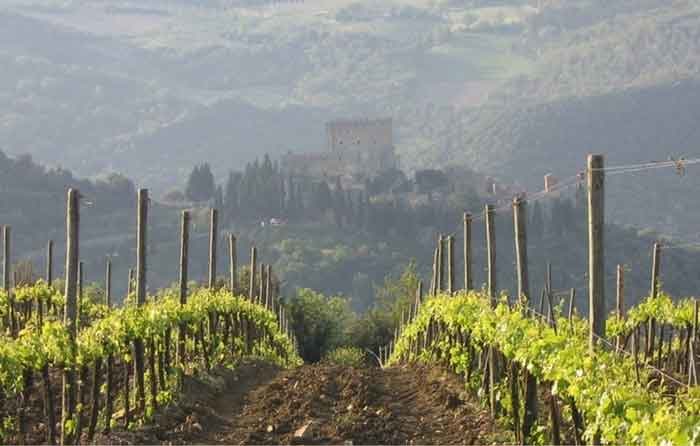 |
||||
| Discover the exellent wines in southern Tuscany | ||||
The Maremma is renowned for its culinary and wine traditions. Experience the best of Tuscany on day tours to Montalcino, Montepulciano, Scansano and the surreal beauty of the Val D'Orcia.
|
||||
Podere Santa Pia |
Podere Santa Pia, garden view, April |
View from Podere Santa Pia
on the coast and Corsica |
||
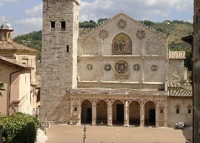 |
||||
The abbey of Sant'Antimo |
Cortona |
Spoleto, Duomo |
||
Montefalco |
Lago Trasimeno |
Florence, Duomo |
||

